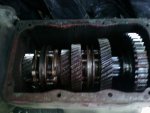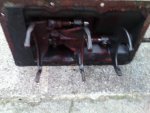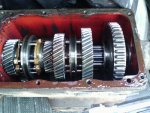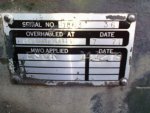Today I was get an 3052 gasser transmission.Inside has some water as it was left outside for a long time.Rust look to be only surface and about at 5 or six teeth of some gears...Tomorrow I will post some pics to evaluate its condition and if it is still usable.Thank you,G
-
Steel Soldiers now has a few new forums, read more about it at: New Munitions Forums!
Water in transmission
- Thread starter MAZ537
- Start date

More options
Who Replied?gimpyrobb
dumpsterlandingfromorbit!
- 27,791
- 788
- 113
- Location
- Cincy Ohio
Probably. Is it seized up?
rustystud
Well-known member
- 9,402
- 3,392
- 113
- Location
- Woodinville, Washington
As long as the bearing surfaces are OK then just sandblast the gears and put in new bearings and call it good !
- 9,582
- 228
- 63
- Location
- Dickson,TN
That trans doesn't look bad at all. I'd first clean up what I could without disassembly, lube with some light oil, and turn it to see how smooth it is. After that, if it turns smooth and no looseness, I'd run it.
Jeepsinker
Well-known member
- 5,399
- 470
- 83
- Location
- Dry Creek, Louisiana
Looks like a runner to me. As long as the bearings aren't rusty.
Jeepsinker
Well-known member
- 5,399
- 470
- 83
- Location
- Dry Creek, Louisiana
That is very common. They almost always have chipped teeth on the first gears.
Jeepsinker
Well-known member
- 5,399
- 470
- 83
- Location
- Dry Creek, Louisiana
3052 is only a four speed I thought.
brianp454
Member
- 572
- 12
- 18
- Location
- Portland, OR
It's definitely a non-overdrive transmission. Here's a pic of mine with OD (3053A):
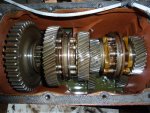
If you look closely at your gearbox you can see the gears make steady stair steps with the smallest at the front.
If you look closely at my gear box there's an odd stair step with the 2nd one from the front as the smallest. This is because direct drive 1:1 is when the foremost synchonizer splines the output directly to the input, or only the foremost sliding sleeve forward.
You may want to think about picking up one of my bearing retainers with a real seal installed. If you don't there's a good chance you will regret it. No seal on the input shaft allows gear oil to drip out onto the clutch and onto your driveway.
http://www.steelsoldiers.com/showthread.php?135217-Oil-seal-mod-for-3053-input-shaft/page8

If you look closely at your gearbox you can see the gears make steady stair steps with the smallest at the front.
If you look closely at my gear box there's an odd stair step with the 2nd one from the front as the smallest. This is because direct drive 1:1 is when the foremost synchonizer splines the output directly to the input, or only the foremost sliding sleeve forward.
You may want to think about picking up one of my bearing retainers with a real seal installed. If you don't there's a good chance you will regret it. No seal on the input shaft allows gear oil to drip out onto the clutch and onto your driveway.
http://www.steelsoldiers.com/showthread.php?135217-Oil-seal-mod-for-3053-input-shaft/page8
brianp454
Member
- 572
- 12
- 18
- Location
- Portland, OR
Sorry I did not finish some thoughts. I started replying just before dinner and had to run.
If you have other questions about the gearing, send me a PM or reply here again.
On the rust. When I got my truck and drained the tranny oil the first time I was alarmed. Lots of metal. I pulled the side access plate and there was a rust line about ½ way up the plate. And at some point almost everything below that line got some rust. There’s a good chance my tranny was submerged at some point and took in water. Or it could have sat out like yours and gotten swapped in.
Another problem with not having a seal on the input shaft is that it also lets water in! This is true when submerged or when day to day changes in the environment, e.g. pressure, humidity, temperature. From time to time there is a burp and water gets in that housing and quickly turns to rust. If it sits out in the rain it will accelerate this phenomenon and get lost of water in there, that again becomes rust.
Back to my tranny. I think it got lots of water in it at some point and when operated the rust getting chewed off the gears made a mess of it. The first change of gear oil I did was a flush. From then to the second it was better and I did it at a close interval. The amount of metal coming out decreased drastically.
Recommendations:
1) Clean the rust, especially on the gear mating surfaces best you can. You can get steel wool in sheets that works well for that sort of thing (rather than the spun stuff that flakes away all the time)
2) Clean anything else left over. Set it on its’ side and blow out with compressed air. Set it in the natural position and flush out with diesel and let it dry
3) Install a magnetic plug for both the fill and drain. This allows you to pull the fill from time to time to clean off the metal and get a chip count without draining it (keep a log book and\or take good pics with the date). This is the same concept used with helicopters. Go NAVY! Also, consider replacing all of the seals. Erik’s has the whole kit for $40
4) Consider adding an input seal while you have it out. Mush easier to do so now…
5) When you do run it, do so for a limited time (maybe 50 miles) and drain the oil. This will allow the worst of it to get flushed without exacerbating wear unnecessarily. Watch it closely and change the oil if you think it should be changed or at increasing intervals, say 50, 150, 500, etc. Eventually you will have “normal” oil change intervals
If you have other questions about the gearing, send me a PM or reply here again.
On the rust. When I got my truck and drained the tranny oil the first time I was alarmed. Lots of metal. I pulled the side access plate and there was a rust line about ½ way up the plate. And at some point almost everything below that line got some rust. There’s a good chance my tranny was submerged at some point and took in water. Or it could have sat out like yours and gotten swapped in.
Another problem with not having a seal on the input shaft is that it also lets water in! This is true when submerged or when day to day changes in the environment, e.g. pressure, humidity, temperature. From time to time there is a burp and water gets in that housing and quickly turns to rust. If it sits out in the rain it will accelerate this phenomenon and get lost of water in there, that again becomes rust.
Back to my tranny. I think it got lots of water in it at some point and when operated the rust getting chewed off the gears made a mess of it. The first change of gear oil I did was a flush. From then to the second it was better and I did it at a close interval. The amount of metal coming out decreased drastically.
Recommendations:
1) Clean the rust, especially on the gear mating surfaces best you can. You can get steel wool in sheets that works well for that sort of thing (rather than the spun stuff that flakes away all the time)
2) Clean anything else left over. Set it on its’ side and blow out with compressed air. Set it in the natural position and flush out with diesel and let it dry
3) Install a magnetic plug for both the fill and drain. This allows you to pull the fill from time to time to clean off the metal and get a chip count without draining it (keep a log book and\or take good pics with the date). This is the same concept used with helicopters. Go NAVY! Also, consider replacing all of the seals. Erik’s has the whole kit for $40
4) Consider adding an input seal while you have it out. Mush easier to do so now…
5) When you do run it, do so for a limited time (maybe 50 miles) and drain the oil. This will allow the worst of it to get flushed without exacerbating wear unnecessarily. Watch it closely and change the oil if you think it should be changed or at increasing intervals, say 50, 150, 500, etc. Eventually you will have “normal” oil change intervals
- 7,032
- 2,690
- 113
- Location
- Montevideo/Uruguay
You saw this picture... and the corresponding gear ratios in that post; that's exactly what you have there.
3053 or 3053A or 3053B doesn't matter, they all have the same ratios.
G.
3053 or 3053A or 3053B doesn't matter, they all have the same ratios.
G.
rustystud
Well-known member
- 9,402
- 3,392
- 113
- Location
- Woodinville, Washington
No their five speeds too. They just have a deeper first gear.3052 is only a four speed I thought.
Jeepsinker
Well-known member
- 5,399
- 470
- 83
- Location
- Dry Creek, Louisiana
Ok, cool. I wasn't sure about it.
So is there any difference in the 3053a and B model? I've never seen a B model.
So is there any difference in the 3053a and B model? I've never seen a B model.
Merry Christmas to all,Today I was start to clean up the transmission, it has a lot of fine metal shavings at the bottom but nothing to worry about...I found one spline on the mainshaft chipped for around 1cm where the 1st/rev gear sits, do I have to worry about it ?Thank you,G
Jeepsinker
Well-known member
- 5,399
- 470
- 83
- Location
- Dry Creek, Louisiana
As long as the gear slides past that spot without catching, it isn't a concern.
brianp454
Member
- 572
- 12
- 18
- Location
- Portland, OR
I agree as long as it hasn't lost too much engagement. Part of the idea of helical cut teeth is to keep 2 teeth engaged at all times so that they share the load. If you run it I would recommend pulling the top plate to inspect it at some point.
Can you post a pic?
Can you post a pic?
As long as the gear slides past that spot without catching, it isn't a concern.
- 114,318members
- 167,209threads
- 2,353,941posts
- 3,727online users


